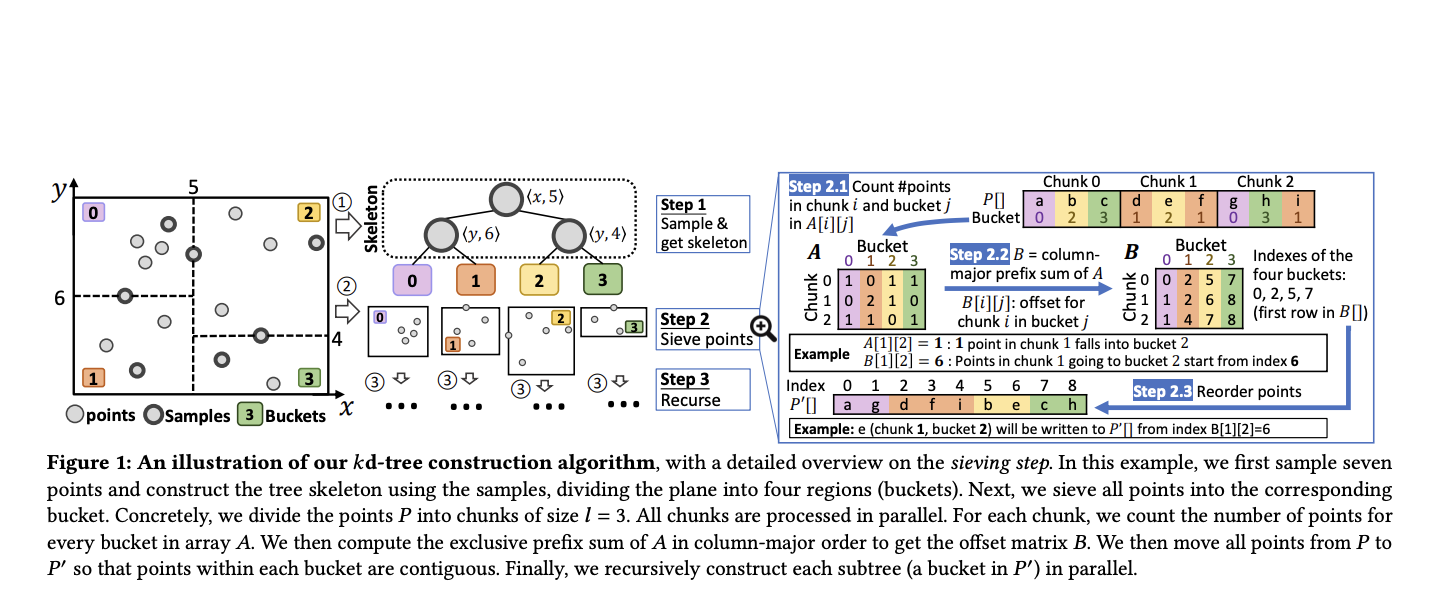
The Challenge of Managing Large Multi-Dimensional Data
As data continues to grow rapidly in fields like machine learning and geospatial analysis, traditional data structures like the kd-tree face significant challenges. These challenges include slow construction times, poor scalability, and inefficient updates, especially in parallel computing environments. Current kd-tree solutions are often static or struggle with large datasets, making it hard to use them effectively in high-performance applications.
Introducing the Pkd-Tree: A Practical Solution
The Pkd-tree (Parallel kd-tree) is a new data structure developed by researchers at UC Riverside. It addresses the limitations of traditional kd-trees by integrating efficient parallelism. The Pkd-tree is designed for fast in-memory operations and supports:
- Parallel Construction: Build the tree quickly.
- Batch Updates: Make multiple changes efficiently.
- Various Query Types: Handle different types of data requests effectively.
This innovative approach significantly enhances the performance of large-scale multi-dimensional data management.
Key Technical Features and Advantages
The Pkd-tree optimizes several important aspects of kd-tree construction and updates:
- Parallel Construction Algorithm: Minimizes workload and increases efficiency.
- Balanced Structure: Uses advanced sampling and sieving to keep the tree balanced.
- Dynamic Updates: Allows for rapid additions and deletions without full rebuilds.
Tests show that the Pkd-tree outperforms existing parallel kd-trees, offering faster construction and updates while maintaining or improving query efficiency.
Real-World Impact and Results
The Pkd-tree solves practical issues that limit the scalability of kd-trees in parallel environments:
- In tests with datasets containing one billion points, the Pkd-tree was 8 to 12 times faster than competitors.
- Batch operations like insertions and deletions were up to 40 times quicker compared to existing methods.
These improvements are due to the Pkd-tree’s weight balancing and cache-efficient design, making it ideal for dynamic, large-scale applications.
Conclusion
The Pkd-tree is a major advancement for managing multi-dimensional data efficiently. It combines theoretical efficiency with practical performance, making it suitable for applications like spatial databases and real-time machine learning. This research from UC Riverside offers a powerful tool for data scientists and engineers, enhancing their ability to work with large datasets effectively.
Check out the Paper. All credit for this research goes to the researchers of this project. Also, don’t forget to follow us on Twitter and join our Telegram Channel and LinkedIn Group. If you like our work, you will love our newsletter. Don’t forget to join our 55k+ ML SubReddit.
[FREE AI WEBINAR]
Implementing Intelligent Document Processing with GenAI in Financial Services and Real Estate Transactions– From Framework to Production
If you want to evolve your company with AI, stay competitive, and use UC Riverside’s Pkd-tree to your advantage:
- Identify Automation Opportunities: Find customer interaction points that can benefit from AI.
- Define KPIs: Ensure measurable impacts on business outcomes.
- Select an AI Solution: Choose tools that fit your needs.
- Implement Gradually: Start small, gather data, and grow your AI usage.
For AI KPI management advice, connect with us at hello@itinai.com. For continuous insights into leveraging AI, stay tuned on our Telegram t.me/itinainews or Twitter @itinaicom.
Discover how AI can transform your sales processes and customer engagement. Explore solutions at itinai.com.


























